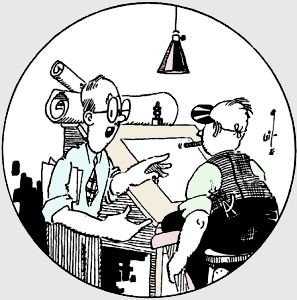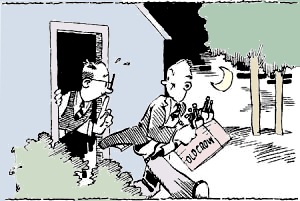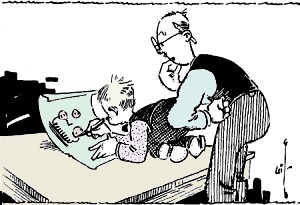Behind the Scenes with Next Year's Model |
||
The expectation of manufacturers to constantly come up with new and better models that outperform last years' models and compel buyers to upgrade is as old as markets themselves. This tongue-in-cheek tale of developers of the "The Dual-Ratio Knee-Action Triple-Hemispheric Multi-Tube Many-Wave Looperdyne" could easily be adopted to describe the prototype lab at Apple, Chevrolet, Panasonic, Microsoft (well, maybe not so much), Hasbro, Lockheed Martin, or Craftsman. Anyone who has worked in the pressure cooker environment of a research, development, and production qualification phases of a project knows all too well the scenario presented here. Behind the Scenes with Next Year's Model
By J. N. A. Hawkins, W6AAR The recent trend toward all-wave broadcast receivers has aroused much interest among amateurs and others, and many have expressed an interest in how the new developments happened to see the light of day. The principles of design are considered quite mysterious and deeply scientific; so we conducted an investigation among the engineering staffs of receiver manufacturers in order to get the story behind the development of a new model. Herewith we present the highlights in the development of a typical receiver, "The Dual-Ratio Knee-Action Triple-Hemispheric Multi-Tube Many-Wave Looperdyne." President tells Chief Engineer that sales are dropping off on current model so a new one is necessary. As the Chief Draftsman is on his vacation, the Chief Engineer gloomily reflects that he will have to use a new man and have to do all his own calculating. Sends to Purchasing Agent a requisition for a copy of the Handbook and a 10-inch slide rule. President sends memo that compactness and portability are the watchwords. Chief Engineer outlines three-tube design to draftsman, with radical new chassis design and spherical bakelite cabinet. Special dies purchased at cost of $1,972.34. Sales Manager points out that he forgot the loud speaker. Dies scrapped. Memo from President: Short-wave reception is the coming thing, and compact sets are on the way out. Chief Engineer makes requisition for subscription to QST, another Handbook and a 16-inch slide rule. Lays out new chassis and designs tuning condensers and coils for 3-to-1 frequency ratio in each band. Draftsman can't read his writing, so provides only a 3-to-1 gear reduction in the tuning dial. Bad intercoupling between various tuning ranges causes continuous dead spots; coil and switching assembly redesigned and shielded. Draftsman points out that new coil assembly won't fit on chassis. Chief Engineer eliminates power transformer and sends memo to President pointing out advantages of new 25Z5 transformerless power supply and full a.c.-d.c. operation. Memo from President points out that 25Z5 rectifier is out, as there are 6,920 type 80 rectifiers still in stock room and must be used up. Chief Engineer lays out new chassis 4 inches wider. Memo from Sales Manager that RCA is planning new Class-C audio amplifier. Chief Engineer scraps audio channel for Class-C type. RCA designer scraps his layouts of Class-C audio amplifier and plans new Class-D-Prime audio amplifier, after hearing that Philco plans to use it. Philco designer scraps Class-D Prime because it takes 10 watts of driver power to get 7 watts of output to the speaker, and adopts new Majestic "Cold Control." Cabinets for the new model arrive from Furniture Manufacturer. Chief Engineer suddenly remembers he forgot to notify Furniture Manufacturer that 4 inches were added to the width of the chassis. Chief Engineer eliminates one i.f. stage, the tuned r.f. stage ahead of the first detector, 8 mikes of filter condenser and washes out the audio transformers in favor of resistance coupling. By mounting 16 resistors and 5 bypass condensers in the half-inch gap between the three-gang condenser and the chassis he manages to squeeze the new layout into the new cabinet. Service Manager points out that power transformer, three-gang condenser and the filter condensers must be removed to test or replace the 16 resistors or the 5 bypass condensers. Chief Engineer buys his silence with case of "Old Crow" and a promise to adopt Crosley Shelvador on future models. President returns from I.R.E. Convention and announces that High Fidelity is the watchword - sensitivity and selectivity must be compromised to obtain it. Design is altered to suit. Class-C audio channel is scrapped for a pair of 845's in Class-A. Shop error makes i.f. shield can five inches in diameter instead of two-and-a-half. In exchange for past favors in covering up his errors, Chief Engineer writes long memo to President pointing out that large shield can raises Q in i.f. transformers and increases gain so that one i.f. stage can be eliminated. President skips involved calculations about large shield cans, tells Shop to eliminate one i.f. stage and add a beat-frequency oscillator for help in finding short-wave stations; also to add an inter-station noise suppressor, as Majestic is reported to have one in their new model. Chief Engineer and Shop Superintendent go into conference and decide that the beat oscillator and the noise suppressor had better be mounted inside of the five-inch i.f. can, and say nothing more about it.
Sends long memo to President suggesting use of two 25Z5's as bridge rectifier. President is somewhat hazy on the Chief Engineer's involved vector diagrams and, as he has also forgotten about the 6,920 type 80 rectifiers still in stock, he OK's the change and tells the Chief Engineer to make it a long-wave receiver for the export business, which is picking up. Chief Engineer sadly adds another set of r.f, and oscillator coils to cover the range from 400 to 150 kc. and thus is forced to change the intermediate frequency from 260 kc. to 465 kc. Receives memo from Purchasing Agent asking whyinhexx he changed the intermediate frequency the day after a shipment of five thousand 260-kc. i.f. transformers arrived from the Coil Manufacturer. First production models show extreme instability and go into oscillation on the least provocation. Since the Foreman of the Sheet Metal Shop does not speak English, the Chief Engineer waves his arms around to show the shape of the new shielding baffle that he wants to put between the i.f. and the first-detector tubes. Misunderstanding him, the Foreman turns out a startling new triple-deck chassis, and orders $3150 worth of dies to make it. The Chief Engineer has a drawing made of the new idea and sends it up to the President, pointing out that his new development will probably triple the sensitivity of the set due to the improved shielding.
Assistant Sales Manager writes letter from field to President asking why dealer delivery promised two months ago is not yet being made, and pointing out bitterly that delivery of new lines by three competitors in his territory has already curtailed future orders by 50%. President sends mandatory order to Production Manager to put out new models without further delay and instructs Sales Manager to lower retail price by $5 and cut dealer discounts in order to compensate for competition. Sales Manager resignedly junks $6100 worth of printed literature in connection with big dealer display program on new model in order to feature new price and so informs President. President figures rapidly that 34% more units must now be sold to make up total investment on the new model, but since this represents an increase of only 120% over their net production of last year does not feel too discouraged and prepares to leave on fishing trip to Canada just as Service Manager discovers that last two changes made in assembly by Engineering Department were unreported to him, with result that all servicing literature and instructions must be recalled and new material issued. As President is boarding train, telegram is handed him from Vice-President in attendance at RMA Convention, where it has been decided that in interests of stabilization of the industry no new home models be introduced during balance of year, but instead that vigorous campaign be launched to popularize automobile radio. President goes fishing. Chief Engineer goes nuts .
Posted August 23, 2022 |
||



